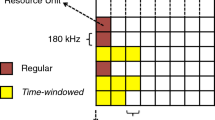Abstract
Time division multiple access offers certain well-known advantages over methods such as spread spectrum code division. Foremost is the interference immunity provided by dedicated time slots. Partly offsetting this is TDMA's need for network-wide synchronization. Viewing arbitrary time intervals as potential TDMA time slots, we ask whether it is possible to obtain some of the benefit of time division without incurring the synchronization cost. In particular, we address the question of whether a TDMA-like state can be induced on asynchronous channels in such a way as to reduce interference and energy consumption. Through analysis and simulation we find conditions under which it is beneficial to use time division, and then show how autonomous power management may be used as a mechanism to induce a form of time division. In this context a backlog-sensitive power management system is presented.
Similar content being viewed by others
References
J. Aein, Power balancing in systems employing frequency reuse, Comsat Technical Review 3(2) (1973).
P.W. Baier, P. Jung and A. Klein, Taking the challenge of multiple access for third-generation cellular mobile radio systems - a European view, IEEE Communications Magazine 34(2) (February 1996) 82–89.
M.S. Bazaraa, H.D. Sherali and C.M. Shetty, Nonlinear Programming: Theory and Algorithms, 2nd ed., Wiley-Interscience Series in Discrete Mathematics and Optimization (Wiley, New York, 1993).
I. Bdira and A. Elhakeem, A radio-link protocol analysis of integrated cdma networks: A comparison with TDMA, in: IEEE International Conference on Universal Personal Communications Record, Vol. 1 (1996) pp. 7–11.
F. Bock and B. Ebstein, Assignment of transmitter powers by linear programming, IEEE Transactions on Electromagnetic Compatibility 6 (July 1964) 36–44.
J.S. da Silva, B. Barani and B. Arroyo-Fernandez, European mobile communications on the move, IEEE Communications Magazine 34(2) (February 1996) 60–69.
G.J. Foschini and Z. Miljanic, A simple distributed autonomous power control algorithm and its convergence, IEEE Transactions on Vehicular Technology 42(4) (November 1993) 641–646.
S. Grandhi, R. Vijayan and D. Goodman, A distributed algorithm for power control in cellular radio systems, in: Proceedings of the 30th Annual Allerton Conference on Communications, Control, and Computing (1992).
S.A. Grandhi, R. Vijayan and D.J. Goodman, Distributed power control in cellular radio systems, IEEE Transactions on Communications 42(2–4) (February-April 1994) 226–228.
S.A. Grandhi and J. Zander, Constrained power control in cellular radio systems, in: Proceedings of the IEEE Vehicular Technology Conference (1994) pp. 824–828.
P.G. Hoel, S.C. Port and C.J. Stone, Introduction to Stochastic Processes (Waveland Press, Inc., Prospect Heights, IL, 1972).
T. Kaneshige, Developments fuel wireless revolution, IEEE Computer 29(8) (August 1996) 16–17.
H.J. Meyerhoff, Method for computing the optimum power balance in multi-beam satellites, COMSAT Technical Review 4(1) (Spring 1974) 139–146.
D. Mitra, An asynchronous distributed algorithm for power control in cellular radio systems, in: Proceedings of the 4th WINLAB Workshop on 3rd Generation Wireless Information Networks (1993).
R.W. Nettleton and H. Alavi, Power control for a spread spectrum cellular mobile radio system, in: Proceedings of the IEEE Vehicular Technology Conference (1983) pp. 242–246.
K. Pahlavan and A.H. Levesque, Wireless Information Networks, Wiley Series in Telecommunications and Signal Processing (Wiley, New York, 1995).
J.M. Rulnick and N. Bambos, Mobile power management for maximum battery life in wireless communication networks, in: Proceedings of IEEE Infocom, Vol. 2 (1996) pp. 443–450.
J.M. Rulnick and N. Bambos, Performance evaluation of powermanaged mobile communication devices, in: Proceedings of IEEE International Communications Conference (ICC) (1996).
J.M. Rulnick and N. Bambos, Mobile power management for wireless communication networks, Wireless Networks 3(1) (March 1997) 3–14.
G.F. Simmons, Differential Equations with Applications and Historical Notes (McGraw-Hill, 1972).
R.D. Yates, A framework for uplink power control in cellular radio systems, IEEE Journal on Selected Areas in Communications 13(7) (September 1995) 1341–1347.
J. Zander, Distributed cochannel interference control in cellular radio systems. IEEE Transactions on Vehicular Technology41(3) (August 1992) 305–311.
J. Zander, Performance of optimum transmitter power control in cellular radio systems, IEEE Transactions on Vehicular Technology 41(1) (February 1992) 57–62.
J. Zander, Transmitter power control for co-channel interference management in cellular radio systems, in: Proceedings of the 4th WINLAB Workshop on 3rd Generation Wireless Information Networks (1993).
Author information
Authors and Affiliations
Rights and permissions
About this article
Cite this article
Rulnick, J.M., Bambos, N. Power-induced time division on asynchronous channels. Wireless Networks 5, 71–80 (1999). https://doi.org/10.1023/A:1019174322111
Issue Date:
DOI: https://doi.org/10.1023/A:1019174322111




